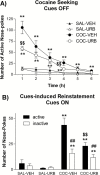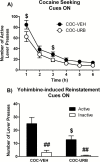Chronic stimulation of the tone of endogenous anandamide reduces cue- and stress-induced relapse in rats
- PMID: 25522382
- PMCID: PMC4368869
- DOI: 10.1093/ijnp/pyu025
Chronic stimulation of the tone of endogenous anandamide reduces cue- and stress-induced relapse in rats
Erratum in
-
Erratum.Int J Neuropsychopharmacol. 2016 Apr 27;19(10):pyw031. doi: 10.1093/ijnp/pyw031. Int J Neuropsychopharmacol. 2016. PMID: 27207904 Free PMC article. No abstract available.
Abstract
Background: The endogenous cannabinoid system plays an important role in motivation, stress, and drug abuse. Pharmacologically, the endocannabinoid system can be stimulated by either agonists of CB1 receptors or inhibition of metabolic degradation of endogenous cannabinoids and consequent increases in their brain levels.
Methods: Here, we investigated whether chronic administration during a period of withdrawal of the fatty acid amide hydrolase inhibitor URB597, which increases anandamide levels, would decrease the risks of relapse to cocaine seeking. Rats were allowed to self-administer cocaine and then they underwent forced withdrawal for 28 days, during which they were treated with URB597 or vehicle. One day after the last injection, we investigated cocaine seeking in one 6h extinction session and relapse triggered by re-exposure to drug-associated cues or a pharmacological stressor.
Results: We found that administration of URB597 significantly decreases cocaine-seeking behavior and cue- and stress-induced relapse.
Conclusion: These results suggest that stimulation of the endocannabinoid system could be helpful to prevent relapse to cocaine addiction.
Keywords: FAAH; abstinence; addiction; chronic treatment; endocannabinoid; psychostimulants; relapse; stress.
© The Author 2014. Published by Oxford University Press. All rights reserved. For Permissions, please e-mail: journals.permissions@oup.com.
Figures


References
-
- Adamczyk P, Faron-Gorecka A, Kusmider M, Dziedzicka-Wasylewska M, Papp M, Filip M. (2012). Long-lasting increase in [(3)H]CP55,940 binding to CB1 receptors following cocaine self-administration and its withdrawal in rats. Brain Res 1451:34–43. - PubMed
-
- Adamczyk P, McCreary AC, Przegalinski E, Mierzejewski P, Bienkowski P, Filip M. (2009). The effects of fatty acid amide hydrolase inhibitors on maintenance of cocaine and food self-administration and on reinstatement of cocaine-seeking and food-taking behavior in rats. J Physiol Pharmacol 60:119–125. - PubMed
-
- Baker DA, Tran-Nguyen TL, Fuchs RA, Neisewander JL. (2001). Influence of individual differences and chronic fluoxetine treatment on cocaine-seeking behavior in rats. Psychopharmacology (Berl) 155:18–26. - PubMed
-
- Bortolato M, Mangieri RA, Fu J, Kim JH, Arguello O, Duranti A, Tontini A, Mor M, Tarzia G, Piomelli D. (2007). Antidepressant-like activity of the fatty acid amide hydrolase inhibitor URB597 in a rat model of chronic mild stress. Biol Psychiatry 62:1103–1110. - PubMed
-
- Bystrowska B, Smaga I, Frankowska M, Filip M. (2013). Changes in endocannabinoid and N-acylethanolamine levels in rat brain structures following cocaine self-administration and extinction training. Prog Neuropsychopharmacol Biol Psychiatry 50C:1–10. - PubMed
Publication types
MeSH terms
Substances
LinkOut - more resources
Full Text Sources
Other Literature Sources
Medical

